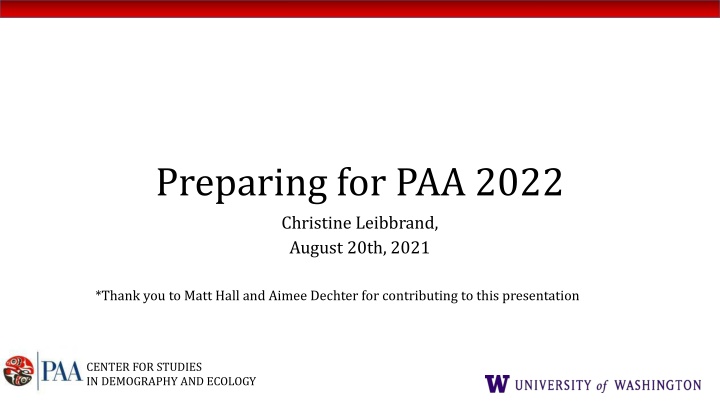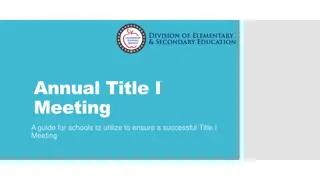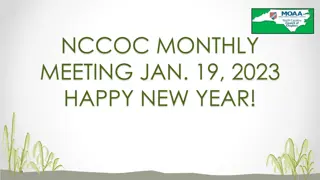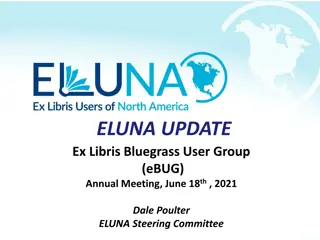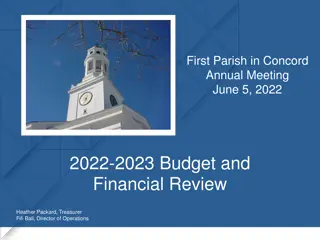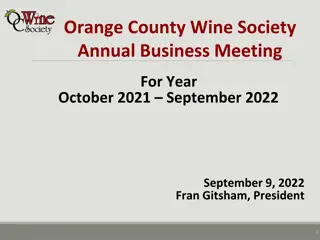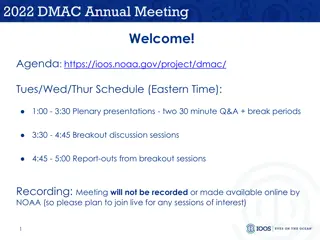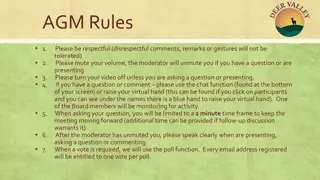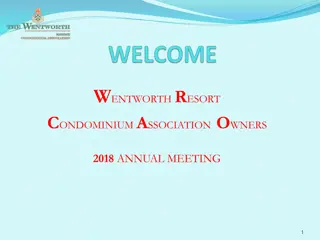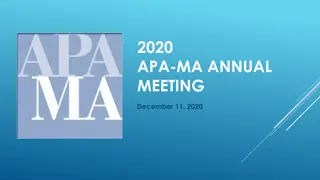PAA 2022 Annual Meeting Highlights
Dive into the details of the PAA 2022 Annual Meeting, featuring insights on demography, research presentations, networking opportunities, and a diverse range of substantive areas explored by attendees. Discover why you should attend this dynamic event and explore the schedule for important dates. Get ready to showcase your work, connect with scholars, and stay updated on cutting-edge approaches in the field. Join us at the PAA 2022 Annual Meeting for a rich exchange of ideas!
Download Presentation

Please find below an Image/Link to download the presentation.
The content on the website is provided AS IS for your information and personal use only. It may not be sold, licensed, or shared on other websites without obtaining consent from the author.If you encounter any issues during the download, it is possible that the publisher has removed the file from their server.
You are allowed to download the files provided on this website for personal or commercial use, subject to the condition that they are used lawfully. All files are the property of their respective owners.
The content on the website is provided AS IS for your information and personal use only. It may not be sold, licensed, or shared on other websites without obtaining consent from the author.
E N D
Presentation Transcript
Preparing for PAA 2022 Christine Leibbrand, August 20th, 2021 *Thank you to Matt Hall and Aimee Dechter for contributing to this presentation CENTER FOR STUDIES IN DEMOGRAPHY AND ECOLOGY
PAA Fundamentals PAA Fundamentals PAA Annual Meeting Atlanta, GA April 6-9, 2022 CENTER FOR STUDIES IN DEMOGRAPHY AND ECOLOGY
PAA PAA PAA is the largest professional organization in demography Publishes the journal Demography Research and outreach focused More than 3,000 members globally PAA Meetings have depth and intimacy Between 2012-2735 people have attended in every year since 2010 30% are students 20% from outside US 40 CSDE students and affiliates presented at the 2021 conference CENTER FOR STUDIES IN DEMOGRAPHY AND ECOLOGY
Meetings Are Organized Around the Following Substantive Areas (by Distribution of Attendees Substantive Areas) Broad and multidisciplinary focus Demography Sociology Social Work Economics Public Health Epidemiology Public Policy Government
Why You Should Attend Why You Should Attend Showcase your work Present and discuss your research with like-minded researchers Valuable and friendly feedback many say they get the best feedback at PAA Good CV builder Generate ideas Identify research gaps Learn about cutting-edge and innovative approaches and techniques Strengthen your research network Opportunities to connect with younger and established scholars Enhance presentation skills Practice, but also learn from successful presentations CENTER FOR STUDIES IN DEMOGRAPHY AND ECOLOGY
2022 Schedule 2022 Schedule July 26: Sept 26: Nov 15-19: Authors notified of regular and flash sessions Dec 6-10: Authors notified of poster sessions March 16: Papers due April 6-9: Conference time (conference in person) Call for Papers Submissions due CENTER FOR STUDIES IN DEMOGRAPHY AND ECOLOGY
Types of Sessions Types of Sessions Regular Oral Presentation (10-15 minutes depending on session) Flash Part 1: Oral presentation (4-6 minutes) Part 2: Posters displayed and informal give and take at each poster Poster Posters displayed and informal give and take at each poster This is a competitive process! PAA usually receives ~4,000 submissions for ~950 oral presentations, ~90 flash presentations, and ~1,050 poster presentations CENTER FOR STUDIES IN DEMOGRAPHY AND ECOLOGY
PAA Submissions Two options for submitting work: Full (or partially full) paper Extended Abstract Also must submit short abstract (150 words) CENTER FOR STUDIES IN DEMOGRAPHY AND ECOLOGY
PAA Submissions Full papers You have the option of submitting a full paper, something I ve taken advantage of many times even if my paper is not close to complete Full papers can have background, theory, hypotheses, and data and methods sections, and no results yet (or incomplete results) If you do not have results, you can describe what you expect to find Given how many papers organizers look at, extended abstracts can be the best way to quickly communicate the contributions of your work CENTER FOR STUDIES IN DEMOGRAPHY AND ECOLOGY
PAA Submissions Extended Abstract A short advertisement for your paper (2-4 pages including tables) Clear and succinct, but detailed enough to communicate merits of work Convince organizers (generally in order) of: Relevance (Why should we care?) Merit or Innovation (What are you doing?) Ability to Complete (Can you pull this off?) Typically consists of: Statement of research question (and the underlying theory/background, if appropriate) Data and research methods Kinds of findings that will likely be presented CENTER FOR STUDIES IN DEMOGRAPHY AND ECOLOGY
Procedures Upload your paper or extended abstract online with a short, 150- word abstract Choose two sessions Organizers of both sessions will evaluate Decide whether you are also willing to present a poster You can submit more than one abstract, but remember that you are only allowed to present in two sessions CENTER FOR STUDIES IN DEMOGRAPHY AND ECOLOGY
Session Organization Rate papers by perceived quality Identify themes among clusters of high-quality papers Assess high-quality submissions for cohesion with other high-quality submissions This process means even great submissions might not get picked if they don t cohere with other sessions choose sessions wisely! Correspond with other organizers who want shared papers Create new themes for potential overflow sessions . Beyond the sessions listed in the program, 80 "overflow" sessions will be created Broad session titles attract more papers and are expected to generate two or three overflow sessions CENTER FOR STUDIES IN DEMOGRAPHY AND ECOLOGY
Tips for a Good Submission Choose your sessions wisely! Main strategy is to find best topical fit Secondarily, consider research interests and approach of the organizer (their taste and knowledge). If unsure, ask mentors, or more experienced researchers who work in that area. Sessions with broader topic areas are likely to receive many more submissions, but are also the most likely to generate overflow sessions CENTER FOR STUDIES IN DEMOGRAPHY AND ECOLOGY
What do Organizers Look for? Quality of Research Advances knowledge, makes a contribution Has scientific merit Appropriate research design Preliminary analyses done correctly Potential Impact Promotes future work (Will it be cited?) Relevance to policy/current events (Who cares?) Effective presentation Will a clear story be told when the paper is finished. Indication author is capable of pulling off the stated goals and completing the paper by the conference CENTER FOR STUDIES IN DEMOGRAPHY AND ECOLOGY
Tips for a Good Submission Have a clear title that conveys purpose of paper Organize your paper well use headings Clearly and concisely illustrate the contribution you will be making reviewers will spend 5-15 minutes reviewing your proposal They often look at 20-150 submissions! An unclear submission may communicate that the presentation will also be unclear Remember this is a competitive conference CENTER FOR STUDIES IN DEMOGRAPHY AND ECOLOGY
Tips for a Good Submission Your contribution could be: Using new data or methods improve validity, enhance robustness of research, potentially ask new questions Identifying a new mechanism, helping to explain a relationship Identifying a new moderator or population of interest Helps illustrate for whom something might be most impactful, targets research attention, identifiers important sources of variability Identifying a new source of spuriousness Looking at a relationship in more detail than has been done previously Challenging prior research Most contributions are incremental and that s not a bad thing! CENTER FOR STUDIES IN DEMOGRAPHY AND ECOLOGY
Tips for a Good Submission You do not need to have any results yet Have a research idea that is doable in the time allotted Clearly articulate what your contribution will be regardless of what the results show For example: If the population or question you are looking at is understudied, it will enhance understanding regardless of what you find If a hypothesized mediator or moderator has a null association, that s helpful for future research, may challenge existing hypotheses, and may indicate that a social phenomena is more widespread or persistent than appreciated CENTER FOR STUDIES IN DEMOGRAPHY AND ECOLOGY
Make Good Use of Tables/Figures Tables and figures should be able to stand alone Have clear and accurate titles, legends, axes Source and sample size identified in title or footnote to table Intelligible color/design scheme used Categories clearly defined If you do not have results yet, a figure of a conceptual model/path diagram can be very helpful and show that you ve put the effort into thinking through your relationships CENTER FOR STUDIES IN DEMOGRAPHY AND ECOLOGY
Figure 1: The relationship between segregation experienced at age 17 and neighborhood poverty rates in adulthood for inter-metropolitan migrant and non-migrant Blacks, results from fully-specified multivariate mixed-effects models. Source: Panel Study of Income Dynamics; n = 18,777 CENTER FOR STUDIES IN DEMOGRAPHY AND ECOLOGY
CENTER FOR STUDIES IN DEMOGRAPHY AND ECOLOGY
Table 3: The Relationship between Exposure to a Shooting and Mothers Symptoms of and Diagnoses of Depression Using Multiple Imputation; Source: Fragile Families and Child Wellbeing Study (FFCWS) Depression Index Bivariate [95% CI] [95% CI] Lagged Outcome Models Witnessed Shooting = 1 0.334 0.214 [0.245-0.422] [0.133-0.294] a c Liberal DC Conservative DC Bivariate OR [95% CI] Bivariate OR [95% CI] Multivariable Multivariable OR [95% CI] Multivariable OR [95% CI] a *** *** *** *** *** *** 1.816 1.583 1.901 1.578 [1.518-2.173] [1.309-1.913] [1.558-2.319] [1.281-1.943] 12,883 4,589 12,883 4,589 12,871 4,588 12,871 4,588 12,846 4,587 12,846 4,587 N Unique IDs Fixed Effects Models Witnessed Shooting = 1 b * * * * ^ ^ 0.095 [0.02-0.17] 0.091 [0.02-0.17] 1.365 [1.05-1.78] 1.392 [1.06-1.82] 1.312 [0.98-1.76] 1.325 [0.98-1.79] 12,954 4,122 12,954 4,122 4,566 1,304 4,566 1,304 3,563 1,020 3,563 1,020 N Unique IDs *p < 0.05, **p < 0.01, ***p < 0.001 aAll models are adjusted for: the outcome lagged one wave, race/ethnicity (White-ref., Black, Latinx, Other), mothers highest level of education (less than high school-ref., high school degree, some college, college+), whether the mother is employed, logged total household income, whether the family is in poverty, whether the mother is married or cohabiting, whether the mother is married or cohabiting with the father of her child, the number of children in the household, state fixed effects, the logged violent crime rate in the county, the poverty rate of the Census tract, and the length (in years) between survey waves cDC = Depression Criteria
Questions? CENTER FOR STUDIES IN DEMOGRAPHY AND ECOLOGY
CSDE Proposal Reviews CSDE Proposal Reviews Submissions are due September 9/26 (Sunday)! Email abstracts to cleibb@uw.edu by Tuesday (9/7) at 12pm. Faculty and peer reviews due on Tuesday (9/14) at 12pm When doing your peer review, focus on: Organization of proposal Soundness of argument Effective display of ability Not on the content or methods CENTER FOR STUDIES IN DEMOGRAPHY AND ECOLOGY
